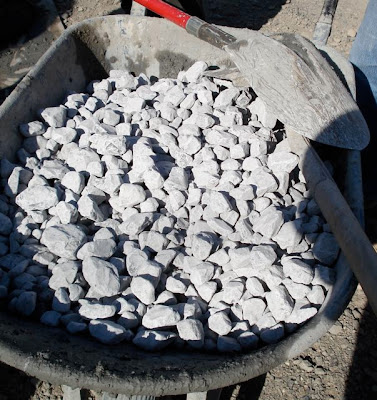Irish stonemason Patrick McAfee was our teacher. Patrick is the author of two excellent books on masonry, Irish Stone Walls and Stone Building, with over 40 years experience. He lives and works in Ireland, an ideal place to practice his stone masonry. As he said “The land was so poor all you could grow was stone.” And they ended up in the 4,000 castles, 25,000 bridges, and 250,000 miles of stone walls found on the Emerald Isle.
As with letter carving and making windows, the process of making lime was easy in the hands of a master. We began by building the kiln, basically a tower of stacked cement blocks. We enhanced it by cutting holes in the corners, to allow air in, laying a metal screen on the first row of blocks, and by holding it together with steel beams and tape. The gang took about 40 minutes to build the kiln.

We put coal and limestone on the screen and continued to add these two ingredients in about equal parts as the kiln grew. And this was all we needed to make lime. We could also have used wood or peat for fuel and shells or marble for our lime source. Our limestone came from Texas but historically builders would have used the local materials, as the Spanish did when they burned shells collected from middens made by people who had lived in the area more than 5,000 years ago.

When we opened the kiln the next day, the limestone had been converted to quicklime, white lumps of CaO. The heat had driven off the CO2, changing the calcite (CaCO3) to quicklime, a highly reactive material when mixed with water, a process known as slaking. The reaction produces lime putty, calcium hydroxide (Ca(OH)2). Lime putty can be used by itself or mixed with an aggregate to make mortar. Patrick told us that lime putty gets better with age, as not all of the quick lime hydrates. The Romans waited at least three years to use theirs and Patrick knew of Polish lime putty aged for more than 100 years.







